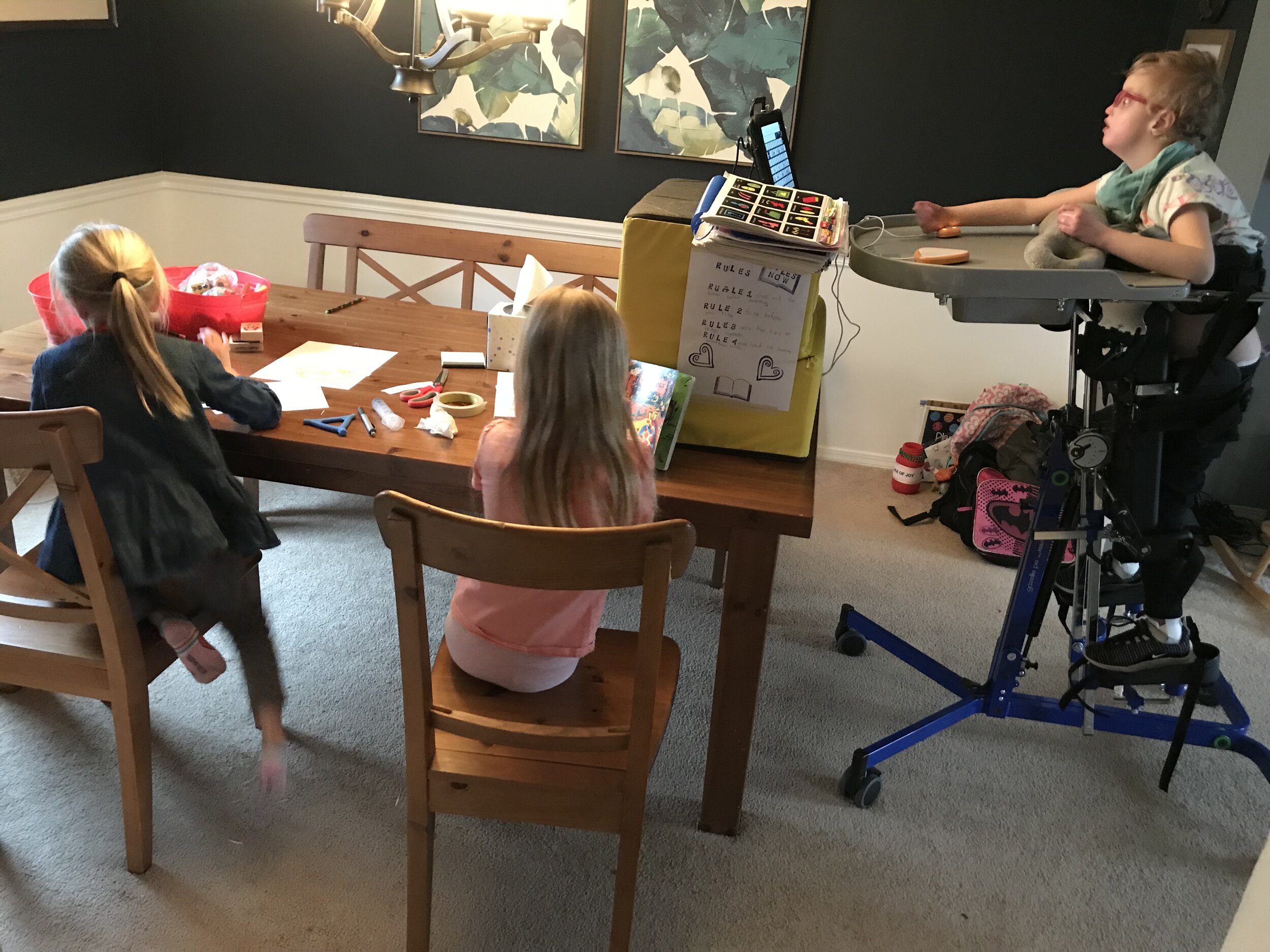How’s everyone doing? I hope you’re finding a new normal, in the midst of shelter-in-place and so much change. We are healthy and at home. The good weather days really help our family, and this weekend was a beauty in Chicagoland. So incredibly grateful for that.
With the weekend behind us, it’s back to business! Our dining room table - no longer set for a rushed weekday breakfast - is once again a one-room schoolhouse. We start the day with a morning meeting, to discuss the date, season and weather, then move on to spelling, writing and math.
Smooth and simple, right?
No way, of course not! Just as soon as I get one girl started on a lesson, another has finished her task and is asking for more work. All the while, the oven alarm is going off. My oldest, who has Wolf-Hirschhorn syndrome, needs frequent mobility changes and regular G-tube bolus feedings. I set a timer as a reminder to make the transitions, or we get way behind schedule. So every 20 minutes - BEEP, BEEP, BEEP - from 8 a.m. to 3 p.m. (and, in truth, well beyond).
I usually reserve our afternoons for science. Perhaps it’s because I like to get the worksheets done first. But I imagine, more likely, it’s because in the morning we’re still warming up, and science asks us to work our minds a little differently. To question and consider. To wonder and test. These moments of hands-on learning are such a nice departure from the paper shuffle.
We’ve dabbled in chemistry, to understand why the Statue of Liberty is green…
We’ve tried our hand at hydrology, to determine what floats and sinks…
We’ve dug into ecology, exploring our backyard habitat…
I’ve gotta say, these have been some of my favorite learning moments, and I’m eager to continue encouraging my little scientists’ curiosity. But science isn’t my area of expertise, and I don’t always know where to start. New picture book DREAM BIG, LITTLE SCIENTISTS (Charlesbridge, 2020) provides an approachable and memorable introduction to twelve branches of scientific study - a great fit for us during remote learning. Here’s the dreamy and delightful cover...
DREAM BIG, LITTLE SCIENTISTS by Michelle Schaub, illustrated by Alice Potter, is a bedtime book that follows kids who love science as they prepare for a good night’s sleep. Poetic, layered and beautifully inclusive, this wonderful story is especially great for April, which holds Earth Day (April 22) and also is National Poetry Month (through April 30). Here are three things that I love about DREAM BIG, LITTLE SCIENTISTS…
Poetic Introduction to Science
DREAM BIG, LITTLE SCIENTISTS is, first and foremost, a cozy bedtime story. In the opening, twelve children stretch and yawn, preparing for sleep. Schaub’s poetry speaks to readers directly, inviting them to enter a dreamland rich with possibility: “Dream big, little scientists, and close your sleepy eyes…”
Then, grab your telescope, because this book is zooming in - right into the lives and bedrooms of each of the twelve little scientists. First, we meet a child who adores astronomy. Then, we meet a child who thinks geology “rocks.” One by one, readers get a glimpse into each little scientist’s interests and passions. Composites of the kid enthusiasts, and their areas of scientific study, begin to form.
Layers of Meaning
What kind of science is featured here? Children are encouraged to scour each spread for clues. Schaub and Potter contribute equally to the hunt. The rhyming text gives hints (“Slumber’s been a part of life since prehistoric days”), while the art hides Easter eggs. Look at the picture below - the labels on the files, the objects on the desktop, the posters on the wall.
Once the scientific branch is uncovered, children who are interested in digging deeper may choose to research a person featured in a portrait (such as English paleontologist Mary Anning, below) to learn more about the life and contributions of a real scientist. Though the detail in each page turn is rich, the touch is light, allowing readers to wonder and dream without losing the cadence of the bedtime rhyme.
Incredible Inclusivity
I always cheer when I come across a picture book that allows many children to see themselves in the pages of a story, and this is one such book. Boys and girls. Children with brown skin and light skin. Differently abled children, too. Lots of kids will see their likeness reflected in these pages.
And not just in the twelve children, but also in the scientists featured on the walls of the bedrooms: anthropologist Mizuko Ito, environmental activist Wangari Maathai, theoretical physicist Stephen Hawking, and many more. It’s clear that great care went into the presentation of each scientific field. This representation matters so very much to children exploring what their future might hold, if they are bold enough to dream it.
It’s really quite remarkable how many hats this story wears. A picture book that explores science broadly, while also lulling children to sleep, is a pretty tall order. But this gentle and inspiring bedtime story accomplishes both with style and substance - delivering a story that can be enjoyed many times over, in many different ways.
DREAM BIG, LITTLE SCIENTISTS can be ordered through your local independent bookstore (support them if you can!) and through the online retailer of your choice.
Michelle Schaub is the author of FINDING TREASURE: A COLLECTION OF COLLECTIONS, illustrated by Carmen Saldana (Charlesbridge) and FRESH PICKED POETRY: A DAY AT THE FARMERS’ MARKET, illustrated by Amy Huntington (Charlesbridge). Alice Potter is the illustrator of THE FANTASTIC PINEAPPLE by Brick Puffinton (Cottage Door Press).
One lucky reader will win DREAM BIG, LITTLE SCIENTISTS, signed by Michelle Schaub!
*** Win DREAM BIG, LITTLE SCIENTISTS ***
Simply...
1. "Like" this post (click the heart below)
2. Follow me (@anitraschulte) on Twitter
3. Retweet my pinned contest tweet by 4/24/20
(Submit a blog comment below and get a BONUS ENTRY!)
GOOD LUCK!










